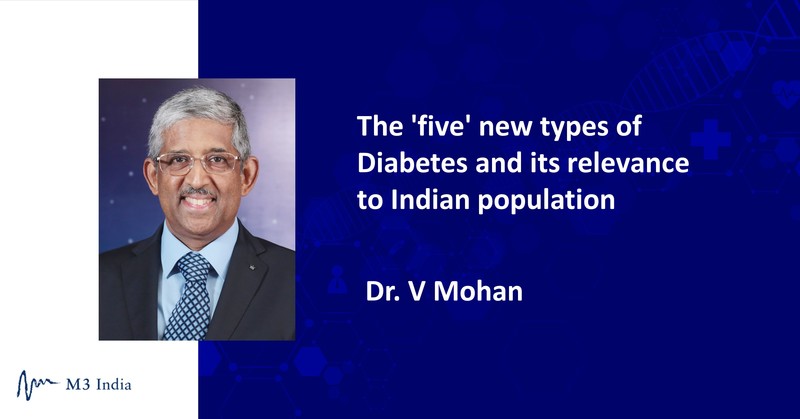The 'five' new types of Diabetes and its relevance to Indian population explained by Dr V Mohan
M3 India Newsdesk Apr 10, 2018
A recent research conducted by Scandinavian researchers reclassified adult-onset diabetes into 5 cluster groups rather than the traditional type 1 and type 2 diabetes, but can there be other forms of diabetes that extend beyond this spectrum?

This article is contributed by Dr. V Mohan, eminent Indian Diabetologist who has been working in the field of diabetes for over 30 years in Chennai in southern India.
The paper from Scandinavia which classified diabetes into 5 clusters has created great interest globally. Based on 5 characteristics namely, age at diagnosis of diabetes, body mass index, HbA1c, GAD antibodies and the homeostasis model assessment to measure beta cell function, insulin resistance, these authors divided diabetes patients into 5 clusters. This is supported by some genomics data too.
- Cluster 1 corresponds to what would normally be classified as classical Type 1 diabetes and GAD antibodies are positive.
- Cluster 2 includes severe insulin deficient diabetes but GAD antibodies are negative. This could include some of the idiopathic (non autoimmune) type 1 patients but it could also include severe insulin deficient forms of type 2 diabetes, e.g. patients who are lean.
- Cluster 3 includes what would be classified normally as type 2, but includes those who have severe insulin resistant diabetes.
- Cluster 4 has patients who have a milder form of type 2 diabetes which is related to obesity but there is no insulin resistance and
- Cluster 5 is mild age-related diabetes which is diabetes occurring at older age groups.
In our day to day practice, we definitely do see patients in all these five clusters of diabetes. We have always known that while type 1 diabetes is fairly a homogenous form of diabetes, type 2 diabetes is a very heterogeneous form of diabetes where there are at least two extreme forms: one with severe insulin resistance and fairly good beta cell function, and the other with severe insulin deficiency and relatively less insulin resistance.
While these are the two ends of the spectrum, there are also patients in the middle of the spectrum, who have both insulin resistance and insulin deficiency in equal measure. For those of us who have been routinely doing C-peptide measurements as well as looking at HOMA measurements and measuring GAD antibodies (as well as other antibodies), we do frequently find these types of diabetes in our practice.
However we can go on to say that, apart from these five clusters of diabetes, there are several other forms of diabetes e.g., monogenic forms of diabetes, Fibrocalcific Pancreatic Diabetes, Endocrine Diabetes, and many others.
At Dr. Mohan’s Diabetes Specialties Centre, we now look for monogenic forms of diabetes when we find cases that appear neither to be typical type 1 nor type 2 and we have been able to identify the various known forms of MODY, (14 types of MODY). In addition, we have also recently described a new form of MODY due to NKX6.1 mutation which we described for the first time in the world. So, if we add these 15 MODY types and additionally include other forms of monogenic diabetes plus secondary diabetes to chronic pancreatic, it is clear that there are at least 30 to 40 types of diabetes.
One has to keep in mind when we treat our patients, we should not think that everyone will have type 1 or type 2 diabetes. This is the basis of what we call as ‘Personalized Diabetes’ or ‘Precision Diabetes’. Last year, we started a department of Precision Diabetes at Dr. Mohan’s Diabetes Specialties Centre, so that we can accurately classify all patients with diabetes who come to us and thus offer them, the most appropriate form of treatment based on the type of diabetes that they have.
In that sense, this is a very important paper which has rightly received wide international and national attention and the authors have to be congratulated on bringing out this paper.
In the years to come, many more (even better) classifications of diabetes will be established thereby helping to make diabetes treatment more ‘personalized’ and thereby improve the therapy for all patients with diabetes and achieve better control than we are able to do at present. These are very exciting times indeed in the field of diabetology.
Disclaimer-The information and views set out in this article are those of the author(s) and do not necessarily reflect the official opinion of M3 India. Neither M3 India nor any person acting on their behalf may be held responsible for the use which may be made of the information contained therein.
-
Exclusive Write-ups & Webinars by KOLs
-
Daily Quiz by specialty
-
Paid Market Research Surveys
-
Case discussions, News & Journals' summaries